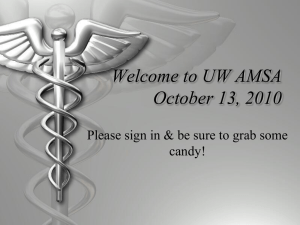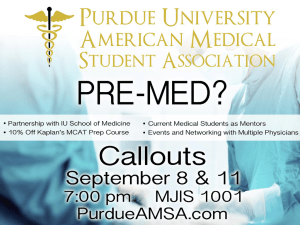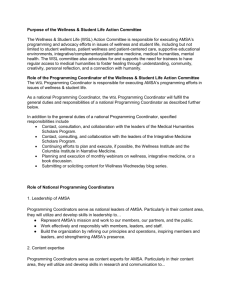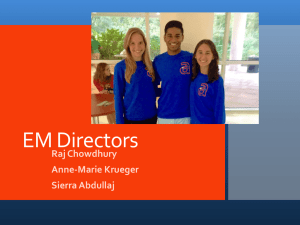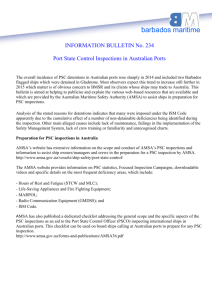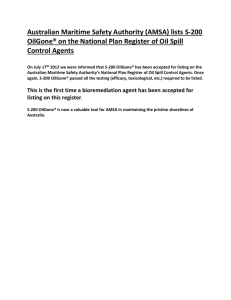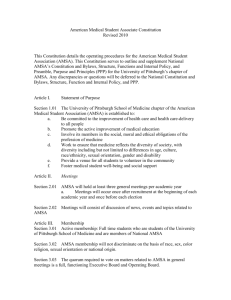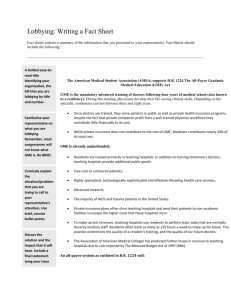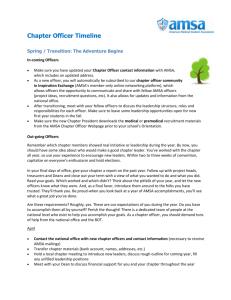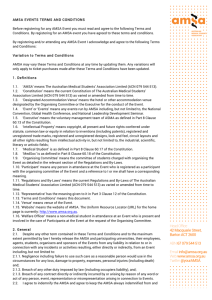to the PowerPoint presentation featured in this video.
advertisement
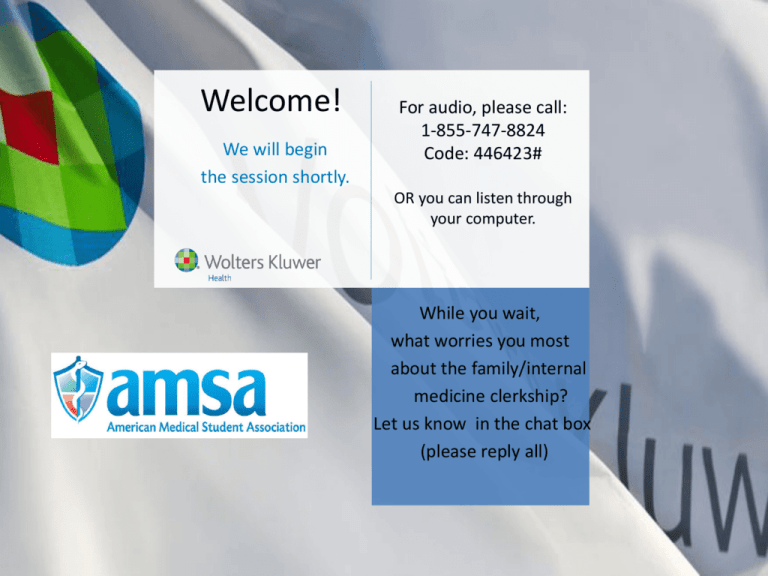
Welcome! We will begin the session shortly. For audio, please call: 1-855-747-8824 Code: 446423# OR you can listen through your computer. While you wait, what worries you most about the family/internal medicine clerkship? Let us know in the chat box (please reply all) Getting Started – Welcome! If calling into the conference line, please make sure to turn down the audio broadcast volume to the lowest setting or adjust your computer volume. If you wish to sit back and listen to the webinar through the computer, you can do so. You will just be able to hear, not speak through the computer. Audio Line 1-855-747-8824 Code: 446423# Your phone line will be muted. If you wish to ask a question or make a comment, you will need to type into the chat or Q&A . You can ask questions by typing in the Chat or Q&A box located on the right side of the webinar room. If the screen is being shared by the presenter, you will find the chat tools at the top tool bar. Just move your cursor to the top of the screen and the toolbar will appear. 2 How to Thrive Webinar Series Family/Internal Medicine Dr. Mark Duncan, author of Shelf-Life Medicine WELCOME AND INTRODUCTION www.amsa.org What year in medical school are you? A) B) C) D) E) MS1 MS2 MS3 MS4 Pre-med www.amsa.org BEFORE WE GET STARTED • Qualifiers • Wellbeing during the rotation and avoiding burnout • Doing well in each clerkship depends on your interaction with the patient, the team, and scoring well on the shelf exam www.amsa.org OUTLINE • • • • • Background Part 1 – The Patient Part 2 – The Team Part 3 – The Shelf Exam Q&A www.amsa.org PREPARATION • Know your team, where to meet the first day, etc. • Know what resources you will use to study for the shelf exam in advance • Have all your equipment ready to go – Maxwell, pen, penlight, stethoscope, scutsheets, reference material, study materials • Scutsheets (http://www.medfools.com/downloads.php) www.amsa.org www.amsa.org www.amsa.org www.amsa.org INPATIENT MEDICINE • Very different than ambulatory medicine and family medicine • Structure: – Non-call days: pre-round, run the list with the intern/resident, rounds, help with the workload (calling consults, procedures, outside records, etc.) + educational activities – Call days: same structure as above while admitting new patients throughout the day (may formally present the patient that day or the next day) • THOROUGHNESS is key www.amsa.org AMBULATORY AND FAMILY MEDICINE • Ambulatory medicine and family medicine are similar • Structure: short patient visits, on-thespot assessment and plan, may work directly with the attending • EFFICIENCY is key www.amsa.org PART 1 THE PATIENT www.amsa.org GENERAL PRINCIPLES • The patient ALWAYS comes first • It may not feel like it, but you have much more time than your residents, so read about your patients and know each of them well www.amsa.org PATIENT CARE • Good rapport goes a long way • Take full responsibility for your patients, but still rely on the rest of the team • A good history and physical exam, documented in a well-written note and presented during rounds, is FOUNDATIONAL – Medical students are expected to be good information-gatherers www.amsa.org PROBLEM LISTING • Inpatient: – First problem: chief complaint, or most serious problem – Any other patient complaints, abnormal physical exam findings, abnormal labs/studies – Chronic problems – Finish with FEN/GI/PPx, code, disposition • Outpatient: – Finish with health care maintenance www.amsa.org REFERENCES • • • • Medicine handbook UpToDate PubMed Read case reports www.amsa.org www.amsa.org PART 2 THE TEAM www.amsa.org “Show me a [med student] who only triples my work and I will kiss his feet.” - Law #11, House of God www.amsa.org GENERAL PRINCIPLES • Team structure, inpatient vs. outpatient • How to impress your attending – – – – Good patient presentations and notes Teaching Staying engaged during rounds Being a team player and NEVER throwing your coworkers under the bus • Ask for feedback, letters of recommendation www.amsa.org PRESENTING YOUR PATIENTS • Inpatient vs. outpatient presentations • There is no perfect presentation, each attending is different and has different expectations! • A concise presentation is the hallmark of clinical maturity, but you have to first earn the trust of your team – Include only the pertinent items – Exclude extraneous information • HOWEVER, you must first earn the trust of your team before making your presentations concise www.amsa.org PRESENTING YOUR PATIENTS • Assessment/Plan section is where you display your reasoning, and is how attendings will judge you • A good A/P sets you apart from many students that act only as information gatherers • Oral presentation guidelines, Steve McGee (https://catalyst.uw.edu/workspace/medsp/3 0311/202905) www.amsa.org TEACHING • Provide teaching to the team: – Short summary of a topic – Presenting a paper • When and how this is done is team and workload dependent www.amsa.org PART 3 THE SHELF EXAM www.amsa.org OVERVIEW OF THE EXAMS • Inpatient Medicine: 110 questions, 2:45 • Ambulatory Medicine: 100 questions, 2:30 • Family Medicine: 80-100 questions, 2-2:30 www.amsa.org How do you feel about the Shelf exam ? A) B) C) D) Prepared Alright Nervous Freaking out www.amsa.org GENERAL ADVICE • Studying begins on day 1 (kind of) • Read to learn, not just to finish the material • Pick the resources that fit your learning style the best • Flashcards for important topics/questions www.amsa.org QUESTION TYPES Pathophysiology (AKA Step 1 type questions; eg, patient presents with hemoptysis and hematuria – mechanism by which this condition causes renal damage is most similar to which other disease process? – bee sting, Graves disease, SLE, poison ivy) Diagnosis (eg, HIV patient coming in with fever, cough, and shortness of breath – what is the most likely diagnosis?) Next step (eg, Alcoholic patient presents to ED with confusion, ophthalmoplegia, and ataxia – next step in management?) “Health and health maintenance” (Other category with random questions about disease screening, prognosis, ethics, etc.; eg, Older male patient presents with UTI, found to have urinary retention relieved with catheterization, prostate exam revealed a diffusely enlarged prostate – he asks you about his chance of having prostate cancer – or he asks you about screening with PSA www.amsa.org RESOURCES www.amsa.org Which of these resources would you consider using? (Check all that apply) Step-Up to Medicine Case Files Internal Medicine Blueprints Medicine PreTest Medicine USMLE World www.amsa.org RESOURCES • Text: Step-Up To Medicine, Case Files, (Master the Wards, Blueprints) • Questions: USMLE World, MKSAP, (NBME Practice Exam, Pretest) • Coming soon: Shelf Life Medicine www.amsa.org Q&A ??? www.amsa.org Thank you for joining us! Make your calendars for the next Thrive webinar on Physiology with Dr. Linda Costanzo, author of BRS Physiology, Tuesday January 20th at 8 pm (ET) www.amsa.org
